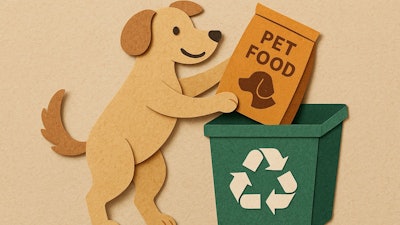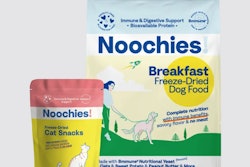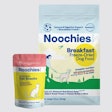
Among the wide range of potential sustainability claims a pet food brand can make, packaging and proteins may offer specific opportunities that resonate with pet owners. Shannon Landry, brand manager for Packaged Facts, explored the importance of recyclable packaging and alternative proteins in the pet food market during her presentation at the Pet Summit on March 24 in Orlando, Florida. She presented survey results gathered from U.S. pet owners in January.
Alternative proteins in pet food
Conventional livestock rearing, especially cattle, has been indicated as using more resources and producing more pollution than alternative protein sources, such as plant and insect proteins.
When asked broadly about alternative proteins in pet food, 49% of pet owners expressed interest. However, responses dropped when alternative proteins were broken down by type:
- Plant proteins: 17% showed interest
- Vegetarian/vegan options: 13% expressed appeal
- Insect proteins: 12% support
- Cultured meat: 9% interest
Pet food company’s marketing related to alternative proteins may be key here, she said. While pet owners are interested in alternative proteins, they want assurance that their pets are getting the same nutrition, even if the protein is unfamiliar.
Recyclable pet food packaging
Along with alternative proteins, recyclable packaging offers opportunities to pet food makers. Pet owners are already familiar with recycling their own product containers and want to recycle their pet food packages as well.
“Eco-friendly packaging is one way that pet market participants can involve pet owners in their sustainability practices,” she said. “Thirty-seven percent of pet owners are willing to pay more for sustainable packaging and recyclable packaging. Only eighteen percent say that they currently purchase sustainable packaging.”
Technological huddles remain for pet food packaging. Few materials can both keep pet food and treats fresh and be recycled via single-stream curbside pick-up. Many of the recyclable pet food packages available now must be returned to stores or otherwise require more of pet owners than simply tossing the bag in the recycling bin at home.
Meeting this challenge could be an important step for pet food makers to meet pet owners’ sustainability demands. When asked what sustainability meant to them, recycling waste topped survey results at 84%.
Recycling bags, alternative proteins and other aspects of sustainability may not be selling points in and of themselves, though. Sustainability should connect with other attributes pet owners want in their dogs’ and cats’ diets.
“Pet sustainability needs to be tied to other aspects of what pet owners are looking for,” Landry said. “Things like health and wellness, and pets as members of their family. These are all ways you can tie your messages together and really attract pet owners.”

















